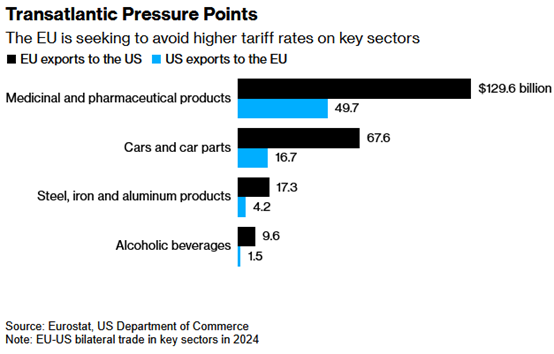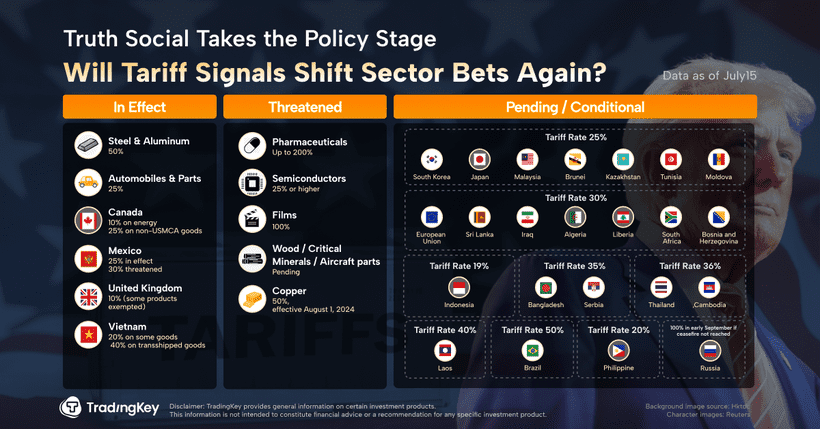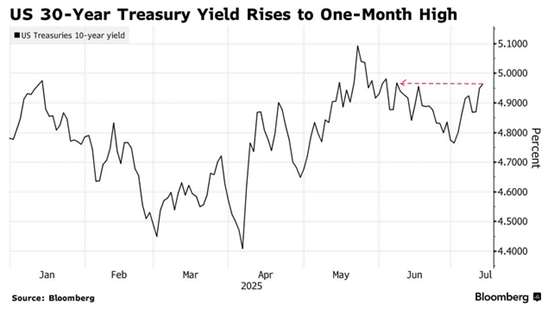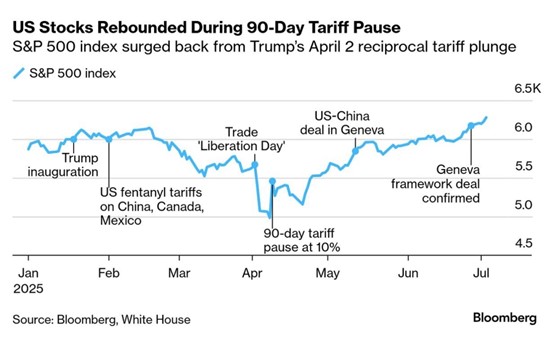Is Now the Time to Invest in U.S. Stocks Amid Renewed Tariff Uncertainty?
TradingKey - On July 7, President Donald Trump posted a letter addressed to 14 world leaders outlining his updated tariff strategy. Starting August 1, the U.S. plans to impose a series of new trade tariffs, with rates “adjusted based on how each country treats the U.S.” Most of these new rates echo the ones he floated back in April during what he called “Liberation Day.”
Not surprisingly, Mexico and Canada—America’s biggest neighbors and trading partners—are front and center again.
In fact, just days after the announcement, Trump said the U.S. will raise existing tariffs on Canadian goods from 25% to 35% beginning August 1. Ottawa isn’t doing enough to stop fentanyl smuggling across the U.S.-Canada border. The comment came after the Canadian government criticized a separate U.S. plan to impose 50% tariffs on copper imports. Keep in mind, Canada is one of the top metal suppliers to the U.S.
The European Union, despite recent trade progress, was also singled out. Trump expressed frustration over Europe’s digital taxes and penalties on U.S. tech companies. On July 12, he said that starting August 1, a 30% tariff would also apply to goods imported from both the EU and Mexico.

EU Commission President Ursula von der Leyen didn’t hold back. She noted the EU remains open to negotiating but said Europe will “take all necessary steps” to defend its interests—including potential countermeasures if needed.
Across Asia, Japan and South Korea are again on Trump’s radar. He reaffirmed plans to slap a 25% tariff on goods from both countries.
Japan, which sent over $148 billion worth of goods to the U.S. last year (making it the 5th-largest source of imports), could be hit hardest—especially the auto industry. Trump has signaled that car tariffs could rise as high as 35%.
Talks haven’t gone well so far. Japan refuses to make concessions on agriculture, particularly around genetically modified crops, and South Korea is being pushed to sign a wide-ranging “package deal” covering everything from defense spending to industrial partnerships—not just a basic trade agreement. That’s raising complexity and stalling progress.
So far, only the U.K., Vietnam, and China have reached preliminary trade frameworks.

Tariffs: From Trade Policy to Negotiation Weapon
What’s new—and arguably more concerning—is how tariffs are now being used to achieve non-trade goals.
For example, Trump recently threatened Brazil with a 50% tariff because of that country’s domestic political issues. It’s one of the clearest signs yet that trade policy may be fully weaponized, say analysts.
Some of the latest threats are even aimed at countries with trade deficits with the U.S.—suggesting that even formal trade deals may not protect against future tariff hikes.
A few days ago, Trump proposed additional duties on BRICS countries (Brazil, Russia, India, China, and South Africa), arguing they promote “anti-American policies.”
His approach to Russia is the most aggressive so far. Trump said if there’s no ceasefire between Russia and Ukraine within 50 days, the U.S. will impose a 100% “secondary tariff” on Russian goods—plus reciprocal penalties on third countries that trade with Russia.
Steven Okun, CEO of APAC Advisors, summed it up: “It signals that countries should still expect Trump to use tariffs to get what he wants—there aren’t many guardrails. He can impose tariffs for any reason, any time.”
Tariffs Already Showing Up in Inflation Data
Markets aren’t ignoring the threat. Even though June’s Consumer Price Index (CPI) matched economist forecasts, inflation crept up versus May. Analysts say that higher tariff costs are already starting to seep into the numbers.
Bond markets reacted. Treasury yields recently hit their highest levels in about a month. Rate futures now suggest that a September Fed rate cut is no longer a sure thing—the odds have fallen to around 50%, according to the CME FedWatch tool.

Core PCE inflation, the Fed’s preferred measure, rose in June at the fastest pace in 5 months. JPMorgan’s chief U.S. economist Michael Feroli estimates that if the proposed tariffs are fully enacted, PCE prices could rise by roughly 0.4 percentage points.
The Fed's Caught Between a Rock and a Hard Place
The high degree of uncertainty stemming from the evolving tariff landscape has kept the Federal Reserve in a wait-and-see mode. Over the past several months, the Fed has held its policy rate steady, awaiting greater clarity on the broader economic impact of Trump’s trade agenda.
At the same time, Trump has continued his public criticism of Fed Chair Jerome Powell, calling him “too slow to act” and even hinting that, if re-elected, he would appoint someone “more willing to cut rates.” Such remarks have undermined confidence in the Fed’s independence and have effectively tied U.S. monetary policy to the administration’s broader trade strategy.
What is beginning to emerge is a “policy illusion chain” within current market dynamics: companies rush to stock up materials and inventory ahead of tariff implementation, keeping short-term inflation readings artificially subdued; in turn, markets do not price in sustained inflation pressures; the Fed finds no urgent reason to raise rates; Trump is emboldened to impose additional tariffs; and structural distortions in pricing mechanics deepen over time.
Both Charles Schwab and Oxford Economics have emphasized that the full downstream effects of high tariffs—on capital investment, inventory policies, and labor markets—have yet to fully materialize. In this environment, today’s seemingly “stable prices” could be concealing growing strains in the underlying structure of the economy due to elevated trade barriers.
Ultimately, the likelihood of the U.S. economy facing a scenario of “imported stagflation” is rising—marked by higher manufacturing costs, weakened corporate investment, and increasing pressure in the labor market.
Is It Still Smart to Buy U.S. Stocks?
Despite the headwinds, some investors are seeing opportunity—especially for short-term or momentum-based trades.
Paolo Schiavone, head of macro trading at Goldman Sachs, thinks we’re still early in a summer “melt-up” rally driven by FOMO (fear of missing out). He advises traders to go with the trend rather than fight it.

His thesis: The U.S. is in the mid-to-late stage of the business cycle. There are no clear signs of recession, corporate earnings remain solid, and rate cut hopes haven’t totally evaporated. Sentiment is improving—but not yet euphoric—leaving room for further upside.
Tech stocks are leading the charge. Nvidia (NVDA), in particular, gained traction after the H20 chip received a green light for exports, and CEO Jensen Huang’s visit to China generated renewed optimism around U.S.–China tech engagement.
Copper stocks also popped after the U.S. floated plans for a 50% import tariff, pushing up prices and lifting earnings and share performance across the sector.
Risk appetite is returning more broadly. Bitcoin and crypto-related stocks (like Circle, Coinbase, MicroStrategy, and Robinhood) are gaining again on inflation fears and safe-haven appeal.
And don’t forget the banks: rising interest rates have widened lending spreads, while increased volatility boosted trading and investment banking activity. That’s helped firms like JPMorgan Chase and Bank of America surpass Q2 earnings expectations.

Get Started Now



